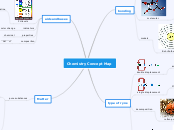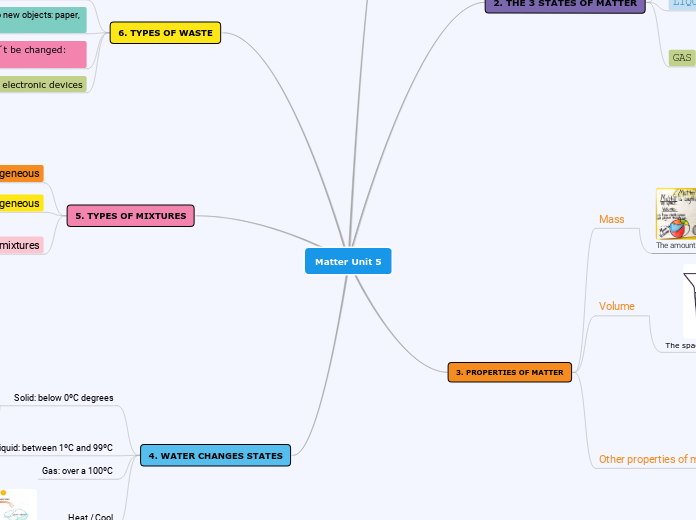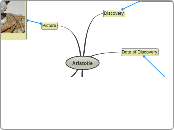Mind Map
Physics
Eye
Cornea
Protects structures inside eye.
Iris
Muscles in the iris control the pupil
Pupil
Lets light into the eye.
lens
Inside the eye, there is a convex lens
Mirrors
Curved mirror/lens
Convex mirror/lens
Diverging mirror
Concave mirror/lens
Converging mirror
Plane mirrors
SALT
Size
Attitude
Location
Type
Diffuse reflection
The reflection of light off a rough surface
Regular deflection
The reflection of light off a smooth surface
Light
Colour mixing (RGB)
-Addictive colour model
-Primary colours
Blue
Green
Secondary colours (CMY)
(Can't connect to 'Red', 'Green', and 'Blue' at the same time)
Yellow
Red + Green
Magenta
Red + Blue
Cyan
Green + Blue
Red
Optics
Light: A wave of energy that travels in different lines which illuminates things.
Opaque
No light passes through.
Translucent
Some light passes through.
Transparent
All light passes through.
Electromagnetic spectrum
Gamma rays
X Rays
Ultraviolet
Visible light
-Red
-Orange
-Yellow
-Green
-Blue
-Indigo
-Violet
Infrared
Microwaves
Radio waves
Climate
Climate change
Greenhouse gases
Natural greenhouse effect
-Natural gas leaks
Atmosphere
The atmosphere traps the sun's heat and other greenhouse gases.
Hydrosphere
Transfers water and heat throughout the atmosphere in the form of water vapor and precipitation.
Biosphere
Traps heat
Albedo effect
The lighter the surface, the higher the Albedo increases, more sunlight is reflected out to space.
Anthropogenic greenhouse gases
Human activity which causes additional emissions of greenhouse gasses.
Nitrous oxide
-Fertilizer
-Gas
-Fossil fuels
Methane
-Coal mining
Carbon dioxide
-Deforestation
-Gas
-Fossil fuels
Mitigation
Avoiding and reducing emissions of heat.
Adaption
Adjusting lifestyles and activities to our changing climate.
IPCC
Intergovernmental
Panel on
Climate
Change
Sustainable farming
+ Healthy diets
Circular economies
Clean energy generation
Incomplete
Fuel + Oxygen --> Carbon dioxide + Water + carbon Monoxide + Carbon (Soot)
Complete
Fuel + Oxygen --> Carbon dioxide + Water
Chemistry
Reactions
Double displacement
Single displacement
Decomposition
Synthesis
Acids and Bases
Neutralization Reaction
A chemical reaction between an acid and a base that produces water and salt
Bases
-Bitter
-Corrosive
-Dissolves in water
-Conducts electricity
-Contains metals
-Produces hydroxide ions when dissolved in water
Metal + Oxygen --> Metal oxide
Metal oxide + Water --> Base
Acids
-Sour
-Corrosive
-Dissolves in water
-Conducts electricity
-Contains non-metals
-Produces hydrogen ions when dissolved in water
Non-metal + Oxygen --> Non-metal oxide
Non-metal oxide + Water --> Acid
Citric
H3C6H5O7
-Sour fruit
-Sour candies
Hydrochloric
HCL
-Stomach acid
Acetic
HCH3COO
-Vinegar (Weak)
-Cleaning product (Strong)
Sulfuric
H2SO4
-Batteries
Carbonic
H2CO3
-Carbonation (Coke, AHA, etc.)
Atom
Ion
Formed when two or more different non-metals combine.
Polyatomic ion
ADD THINGS
Anion
-Negatively charged ion
-Non-metal
Cation
-Positively charged ion
-Metal
Electron
-Negative charge
-Mass of 0
Neutron
-Neutral
-Mass of 1
Proton
-Positive charge
-Mass of 1
Properties of matter
Property: A characteristic that can be used to describe or identify a substance.
Changes of matter
Chemical change
Physical change
Chemical property
Reaction to acids and bases
Combustion
Corrosion
Quantitative
(Number)
Density
Boiling point
Melting point
Qualitative
(Physical)
Solubility
Clarity
Texture
Smooth or rough
Luster
Shiny or dull
Subtopic
Colour
State
Solid, liquid, gas
Matter
Mixtures
Homogeneous mixtures
Solutions
Heterogeneous mixtures
Sustentions
Mechanical mixtures
Pure substance
Elements
Compounds
Molecular compounds
Ionic compounds
-Simple binary
-Multivalent metals
-Polyatomic ions
Biology
Microscope
Base
Arm
Stage
Supports the slide for observation
Stage clips
Holds the slide in position on the stage
Eyepiece
10X Magnification
Objective lenses
Low power lens
4X Magnification
Medium lens
High power lens
40X Magnification
Plant systems
Plant cells
(Also includes all animal cells)
Cell wall
Provides support and strengthens the cell. Also gives the cell its shape.
Chloroplast
Allows plants to capture the energy of the sun in energy-rich molecules.
Photosynthesis
Root and Shoot
Vascular tissue
Transports substances from the roots to the leaves.
Ground tissue
Stem: Provides strength and support.
Roots: Stores food and water
Leaves: Where photosynthesis occurs
Epidermal tissue
Forms the protective outer covering.
Meristematic tissue
-Responsible for growing new parts of the plant.
-Unspecialized tissue capable of dividing by Mitosis
Human organ systems
Animal cells
Organelles
Cell parts
Vacuole
Animal: Helps squeeze out waste products.
Plant: Is bigger and helps maintain shape.
Lysosome
Breaks down food, waste, and other materials.
Golgi bodies
Packages useful materials and sends them outside the cell.
Mitochondria
Powerhouse of the cell, creates ATP/energy.
Ribosomes
Makes protein.
Endoplasmic reticulum
Transports materials throughout the cell.
Cytoplasm
Supports the cell and organelles.
Nucleolus
Creates ribosomes.
Chromatin
DNA stores the instructions for the cell's jobs.
Nuclear membrane
Separates the inside of the nucleus from the rest of the cell.
Nucleus
Acts like a container. It holds the DNA and the nucleolus inside
Cell membrane
Regulates the transportation of materials entering and exiting the cell.
Mitosis
Cell cycle
Interphase
-Repair
-Cell activity
-Preparing for mitosis
Prophase
Chromatin condenses into chromosomes
Metaphase
The chromosomes line up in the middle
Anaphase
The chromosomes split apart
Telephase
The chromosomes go to the opposite ends of the cell (Creating two sister cells)
Cytokinesis
The cytoplasm pinches and splits.
Cellular respiration
Glucose + Oxygen = ATP + Water + Carbon dioxide
ATP
Apoptosis
Cell death.
Tumor
(Apoptosis failure)
Benign
Not cancerous.
Malignant
Cancerous.
Cancer
Cancer cells are 'immortal' because they never stop dividing. A normal cell will undergo apoptosis if it is damaged genetically, whereas a cancer cell will continue to divide.
Immunotherapy
Treatment that uses a person's own immune system to fight cancer
Surgery
Physically removing the cancerous tumor
Chemotherapy
Chemotherapy is a drug treatment that uses powerful chemicals to kill fast-growing cells.
Radiation therapy
Radiation therapy is a cancer treatment that uses high doses of radiation to kill cancer cells and shrink tumors.
Circulatory system
Blood
Connective tissue
Heart
Muscular tissue
Arteries
Veins
Capillaries
Respiratory system
Trachea
Once the oxygen has passed into the nose or mouth, it enters the windpipe or trachea.
Lungs
Bronchi
The trachea branches into the right and left bronchus, which are tubes designed to carry air into the lungs.
Bronchioles
The bronchi branch further into many tinier tubes.
Aveoli
O2 and CO2 are exchanged with the blood.
Digestive system
Mouth/teeth/saliva
throat
Stomach
Tissues
Muscular
Muscular tissue to churn food in stomach.
Epithelial
Protective outer layer of stomach.
Small intestine
Villi
Villi are tiny ripples in the small intestine, increasing surface area to absorb more nutrients.
Micro villi
Micro villi are very tiny ripples in the small intestine, further increasing surface area to absorb more nutrients.
Large intestine









